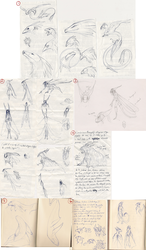Sign In
CloseHi ho, another dragon sketchdump! Now that I've been back in university, most of my latest doodles have been scribbled in the margins of my notes in class rather than on receipts like my last couple sketchdumps. Numbered for easy reference, though this time I've stuck a few extra lines in there as well to define between batches of sketches, see which ones are supposed to go together.
If you have any questions about a particular species, please don't hesitate to comment!
-=-=-=-=-=-
(1) More concepts for the Drifters, particularly in defining their facial features. After ages of struggling with giving them a reptilian face, I decided to actually attempt something slightly more mammilian, and I think I've got it! They have nostrils like seals which they can close tightly, and very expressive ears with hidden earholes (just behind the base gap between the top two spines). Also illustrated is a quick growth chart from a baby Drifter to an adolescent, as well as a male Drifter, as the males have a single prominent horn on their faces just above the nostrils.
(2) A reclining Mistongue, and a close-up of the head. These dragons are closely related to the Drifters, though are more river and lake dwellers, and have a more crocodilian appearence. Their bodies are essentially the same though, just without a Drifter's thick fur.
(3) Oracles, a dragon known for living in caves behind and around waterfalls. While they do have eyes, they predominantly utilize the tendrils on their face to explore their surroundings and interact with objects. They are also one of the few dragon species that do not have arms or legs.
(4) Above is a Mossgiant, and below is a Mossdancer. These dragons are immensely unique in the fact that they are actually of the same species! From a species lovingly nicknamed "Mossers", the Mossgiants are the females, while the Mossdancers are the males. Both dragons are well known for the growth of plants on their backs, and their protectiveness of nature. Most people don't make the connection between the two dragons because of their vast differences not only in appearence, but in size. A Mossdancer may stand over 10 feet tall at the horn tip, while a Mossgiant has a small forest's worth of trees growing on their back, and their own ecosystem!
(5) The Tidewells, a deceptive species of Deeplander. Technically an earth dragon instead of a water dragon, this giant sea turtle dragon uses the holes in its shell to gather, suppress, and release air and water to aid in controlling its buoyancy when swimming. Because of the nature of their gaiamenta, they can also use blasts of concentrated vibrations and soundwaves to cause an explosive eruption of water from inside their shells or in the water around them, to use as a distraction for escape or as a warning to other dragons.
(6) The Boughban, a very unique Deeplander dragon heavily based on an anteater. Feeding on pine needles and tree leaves, these dragons utilize a very specific sort of camoflage, raising their long scales on end like a hedgehog in order to blend into the boughs of a large tree, or to disguise themselves in the bushes. They are herbavores and usually very shy, tending to startle easily and keep to themselves in the wilderness.
(7) The Hydracampus, a species of tropical Northlander based on the leafy sea dragon, a type of unique seahorse. They have bright and gorgeous colours that vary depending on the location of their habitats and the temperature of the water.
(8a) Initial concepts for the Humasuro, a dragon I used to call a "Dawnwing". They're very much based on the stereotypical portrayal of the gryphon, though it's obvious I'm having trouble completely defining them here.
(8b) The finalized design for the Humasuro! Transcript of text:
- Longest tail of any dragon! Albatross-esque wings.
- Their tail collects Zephmenta in fur from clouds like how a bee's fur collects pollen. It also collects static electricity that the Humasuro store in their light, whispy fur. Much clean moisture off.
Fun fact! I based the name for the Humasuro after a combination of: the Huma/Homa bird, a legendary bird from Persian mythology that is said to fly endlessly and never land on the ground, and Illusuro, the humanoid bird species from Ahnurth that are supposed descendants of these dragons.
(9) The Prismith, a strange species of Spirelander that appears to be insectoid in nature with gecko-like features. Their huge, pupilless eyes allow them to take in all of their surroundings at once, and they charge electricity through the membranes of their wings to make the patterns light up and vibrate. Their mantis-like claws are hidden beneath their bodies between two pairs of forelegs.
(10) On the left is my resulting brainstorming for a Riftlander called the Obsidian Guard, based partially on the Atlas beetle. Their transluscent golden wings are hidden beneath the hard carapace of their wing covers, and do not help the dragon to fly, only glide and control their falling. They also have an extra long, sharp scythe-like claw that they use to hold down and slice open, as they can be rather clumsy in the use of their horns for goring prey at close range.
On the right is a concept for another Riftlander that lives and swims in lava. I haven't finalized a name for these yet. The text reads:
- A lava dwelling dragon with the strength and resiliance to "swim" in lava.
- "wing" membranes are thick and opaque, flexed to help release excess heat when out and away from lava?
- consumes minerals as well as organic flesh. Can prey on Ounten with relative success.
Submission Information
- Views:
- 395
- Comments:
- 0
- Favorites:
- 1
- Rating:
- General
- Category:
- Visual / Sketch




